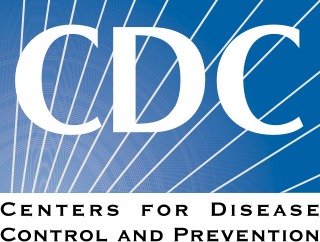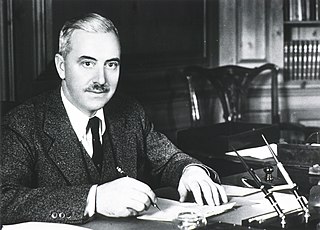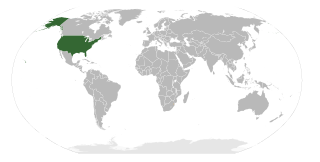Related Research Articles

The Centers for Disease Control and Prevention (CDC) is a national public health institute in the United States. It is a United States federal agency, under the Department of Health and Human Services, and is headquartered in Atlanta, Georgia.

Syphilis is a sexually transmitted infection caused by the bacterium Treponema pallidum subspecies pallidum. The signs and symptoms of syphilis vary depending in which of the four stages it presents. The primary stage classically presents with a single chancre though there may be multiple sores. In secondary syphilis, a diffuse rash occurs, which frequently involves the palms of the hands and soles of the feet. There may also be sores in the mouth or vagina. In latent syphilis, which can last for years, there are few or no symptoms. In tertiary syphilis, there are gummas, neurological problems, or heart symptoms. Syphilis has been known as "the great imitator" as it may cause symptoms similar to many other diseases.

The Tuskegee Study of Untreated Syphilis in the Negro Male, was an unethical natural history study conducted between 1932 and 1972 by the United States Public Health Service (PHS) and the Centers for Disease Control and Prevention (CDC). The purpose of this study was to observe the natural history of untreated syphilis; the African-American men who participated in the study were told that they were receiving free health care from the federal government of the United States.

The United States Public Health Service (USPHS) is a division of the Department of Health and Human Services concerned with public health. It contains eight out of the department's eleven operating divisions. The Assistant Secretary for Health (ASH) oversees the PHS. The Public Health Service Commissioned Corps (PHSCC) is the federal uniformed service of the USPHS, and is one of the eight uniformed services of the United States.

Thomas Parran Jr. was an American physician and Public Health Service officer. He was appointed the sixth Surgeon General of the United States from 1936 to 1948, and oversaw the notorious Tuskegee syphilis experiment and Guatemala syphilis experiment.

The Epidemic Intelligence Service (EIS) is a program of the U.S. Centers for Disease Control and Prevention (CDC). The modern EIS is a two-year, hands-on post-doctoral training program in epidemiology, with a focus on field work.

Sexual health clinics specialize in the prevention and treatment of sexually transmitted infections.
To the People of the United States is a short propaganda film produced by the US Public Health Service in 1943 to warn the American GIs against syphilis. It was directed by Arthur Lubin and produced by Walter Wanger. The film was subject to protests from the Catholic Legion of Decency.

The American Sexual Health Association (ASHA), formally known as the American Social Hygiene Association and the American Social Health Association, is an American non-profit organization established in 1914, that cites a mission to improve the health of individuals, families, and communities, with an emphasis on sexual health, as well as a focus on preventing sexually transmitted infections and their harmful consequences. ASHA uses tools such as education, communication, advocacy and policy analysis activities with the intent to heighten public, patient, provider, policymaker and media awareness of STI prevention, screening, diagnosis and treatment strategies.

Sexually transmitted infections (STIs), also referred to as sexually transmitted diseases (STDs), are infections that are commonly spread by sexual activity, especially vaginal intercourse, anal sex and oral sex. STIs often do not initially cause symptoms, which results in a greater risk of passing the disease on to others. Symptoms and signs of STIs may include vaginal discharge, penile discharge, ulcers on or around the genitals, and pelvic pain. STIs can be transmitted to an infant before or during childbirth, which may result in poor outcomes for the infant. Some STIs can cause infertility.

The syphilis experiments in Guatemala were United States-led human experiments conducted in Guatemala from 1946 to 1948. The experiments were led by physician John Charles Cutler who also participated in the late stages of the Tuskegee syphilis experiment. Doctors infected soldiers, prostitutes, prisoners and mental patients with syphilis and other sexually transmitted diseases, without the informed consent of the subjects. The experiment resulted in at least 83 deaths. Serology studies continued through 1953 involving the same vulnerable populations in addition to children from state-run schools, an orphanage, and rural towns, though the intentional infection of patients ended with the original study. On October 1, 2010, the U.S. President, Secretary of State and Secretary of Health and Human Services formally apologized to Guatemala for the ethical violations that took place. Guatemala condemned the experiment as a crime against humanity, and a lawsuit has since been filed.
Mary Guinan, Ph.D., M.D. is the dean at the School of Community Health Sciences at the University of Nevada, Las Vegas. Guinan is known for her work in the initial investigation of the HIV/AIDS epidemic for the Centers for Disease Control and Prevention (CDC). The book and subsequent film And the Band Played On, by Randy Shilts documented her efforts regarding these issues; she was played by Glenne Headly. Later on, she became the first female State Health Officer appointed to the Nevada government. Guinan also became president of the American Medical Woman's Association, after 40 years of membership.
The outbreaks of sexually transmitted diseases in World War II brought interest in sex education to the public and the government. During the late 1930s and early 1940s, military maneuvers increased worldwide and sexual hygiene and conduct became major problems for the troops. Soldiers and sailors on assignment overseas were often lonely, had time to spare, got homesick, or were just looking for female companionship. This resulted in many men having multiple sex partners, and as a result, became a major health concern. During the Great War, venereal diseases (V.D.) had caused the United States Army to lose 18,000 servicemen per day. Although by 1944 this number had been reduced 30-fold, there were still around 606 servicemen incapacitated daily. This drop in numbers was partly because of the Army's effort to raise awareness about the dangers faced by servicemen through poor sexual hygiene, and also because of the important developments in medicine. In late 1943 a case of gonorrhea required a hospital treatment of 30 days, and curing syphilis remained a 6-month ordeal. By mid-1944, the average case of gonorrhea was reduced to 5 days, and in many cases the patient remained on duty while being treated.

Dr. John Roderick 'Rod' Heller, was the head in 1943-1948 of what was then called the "Venereal Disease" section of the United States Public Health Service (PHS). He then became the director of the National Cancer Institute, and then president/chief executive officer of the Memorial Sloan-Kettering Cancer Center in New York City. He is best known for having been the assistant in charge of on-site medical operations in the Tuskegee syphilis study, a longitudinal clinical examination by PHS of untreated syphilis in U.S. African-American males. Very serious questions of medical ethics have been raised about this study and those involved in it.

Joseph Walter Mountin MD was an American physician and career United States Public Health Service (USPHS) officer who was the founder of the U.S. Centers for Disease Control and Prevention in Atlanta, Georgia. Mountin eventually became an assistant surgeon general. He was involved in many advancements in medical and sanitary science during his lifetime. He was an early advocate for a national health care system and wrote frequently on the need to provide broader health care coverage. He was considered influential in the development of public health improvements.

La Follette–Bulwinkle Act or Venereal Diseases Control and Prevention Act of 1938 sanctioned federal assistance to U.S. states establishing preventive healthcare for venereal diseases. The United States federal statute commissioned the United States Public Health Service for demonstrations, investigations, and studies as related to the control, prevention, and treatment of opportunistic infections. The public law amended the Army Appropriations Act of 1918 appending the judicial context which created the Division of Venereal Diseases within the Bureau of the Public Health Service.

The Chamberlain–Kahn Act of 1918 is a U.S. federal law passed on July 9, 1918 by the 65th United States Congress. The law implemented a public health program that came to be known as the American Plan, whose stated goal was to combat the spread of venereal disease.
This is a timeline of the United States Public Health Service Commissioned Corps and its predecessor, the Marine Hospital Service.
The Division of Global Migration and Quarantine (DGMQ) is the part of the U.S. government responsible for U.S. Quarantine Stations and issuing quarantine orders. It is part of the National Center for Emerging and Zoonotic Infectious Diseases within the Centers for Disease Control and Prevention (CDC).

The Bureau of State Services (BSS) was one of three principal operating agencies of the United States Public Health Service (PHS) from 1943 until 1966. The bureau contained the PHS divisions that administered cooperative services to U.S. states through technical and financial assistance, and included significant programs in community health, environmental health, and workforce development.
References
- ↑ Fitzhugh Mullan, Plagues and Politics: The Story of the United States Public Health Service (New York: Basic Books, 1989)
- 1 2 3 Elizabeth W. Etheridge, Sentinel for Health: A History of the Centers for Disease Control (Berkeley: University of California Press, 1992).
- ↑ Thomas Parran, "Why Don't We Stamp Out Syphilis?" Reader's Digest (July 1936): 65-74.
- 1 2 3 Thomas Parran, Jr. (1937), Shadow on the Land: Syphilis Baltimore, MD: Waverly Press, 1937, 54, 62.
- ↑ Raymond A. Vonderlehr, Herman N. Bundesen, Lida J. Usilton, et al., "Recommendations for a Venereal Disease Control Program in State and Local Health Departments." Report of the Advisory Committee to the U.S. Public Health Service. Venereal Disease Information 17, no. 1, reprint No. 54.
- ↑ Journal of the American Medical Association 106 (January 1936): 115-117. Washington, January 1936.
- ↑ Lida J. Usilton, "Mortality Trends for Syphilis," Journal of Venereal Disease Information, 27 (February, 1946): 47-52.
- ↑ Allan M. Brandt, No Magic Bullet: A Social History of Venereal Disease in the United States Since 1880 (New York: Oxford University Press, 1987). See also Raymond A. Vonderlehr and Lida J. Usilton, "The Extent of the Syphilis Problem at the Beginning of World War II." New York State Journal of Medicine 43 (October, 1943): 1825. Also found in American Journal of Syphilis, Gonorrhea and Venereal Diseases, 27 (November 1943): 686.
- ↑ Thomas Parran, "Syphilis: A Public Health Problem," in Syphilis, ed. Forest Ray Moulton, (Lancaster, PA: The Science Press, 1938), 187-193.
- 1 2 3 Beth E. Meyerson, Fred A. Martich and Gerald P. Naehr, Ready to Go: The History and Contributions of U.S. Public Health Advisors (Research Triangle Park: American Social Health Association, 2008).
- ↑ Gerald Naehr, "PHA Response to International and Domestic Crises" (Attachment IV). Attachment to unspecified recruitment document. E-mail communication with author Beth Meyerson dated December 6, 2007; Centers for Disease Control and Prevention, "Bureau of State Services Field Assignee Participation in Special Details 1965–1979" (July 11, 1979). (Partial Data). Found as "Tab B" to a document that was not present in the Watsonian Society Archives and could not be located.; Centers for Disease Control and Prevention, "Field Assignee Participation in Special Details Partial List Center for Prevention Services 1965–1984" (July, 1984). Found as "Appendix D" to a document that was not present in the Watsonian Society Archives and could not be located; Centers for Disease Control and Prevention, "Examples of Short-and-Medium-Term PHA Responses" (July, 1984). Found with a document marked "Table 9" of a document that was not present in the Watsonian Society Archives and could not be located.
- ↑ Centers for Disease Control and Prevention, "Field Assignee Participation." See note 10.